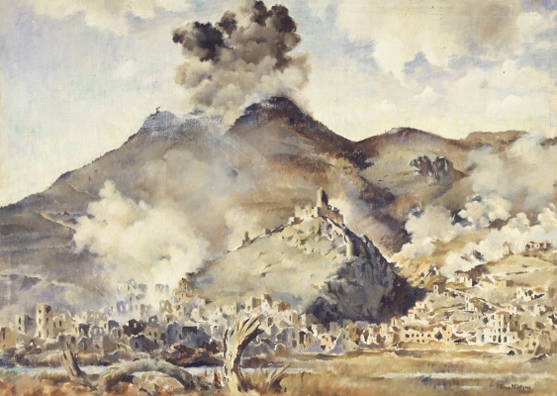| Bombing Cassino
By Dave Murray
December 2012
“I don’t know how a monastery
can be evil, but it was looking at you.
It was all-devouring, if you like —
a sun-bleached colour, grim. It had a terrible
hold on us soldiers. I don’t think
I was convinced that the Germans were firing
from there, but it was such a wonderful
observation post.” Sergeant Evens
of the 2nd London Irish, 78th Division.
At around 0930 on 15 February 1944, the Germans
stationed around Monte Cassino began to hear
the drone of Allied aircraft approaching.
It was not long before they realised the intended
target. One hundred thirty-five B-17 Flying Fortresses
dropped 287 tons of 500-lb bombs and 66 tons
of 100-lb incendiaries in and around the monastery,
which had stood undisturbed for centuries.
Following the B-17s were 47 B-25 Mitchells
and 40 B-26 Marauder medium bombers, dropping
a further 140 tons of high explosive.
As soon as the bombers had dropped their
last bombs the artillery opened up with a
sustained barrage on the ruins.
The monastery was quickly shrouded in smoke
and dust that took several hours to fully
clear. Allied troops cheered the bombers but
the Germans were baffled — they had
not stationed any troops within the monastery.
The effect of the bombing is still a controversial
issue and subject to much debate. A German
officer, Lt. Daiber, said it was “as
if the mountain had disintegrated, shaken
by a giant hand.”
New Zealander Brick Lorimer said it was “soul-destroying
to watch. . . . [T]he realisation settled
on us finally what we were here for, and it
was essentially a sad time.”
Eric Smith, a Gurkha officer, wrote in his
diary: “The Allied air forces bomb the
monastery. Awe-inspiring to watch. It is now
shrouded in dust. There was no opposition
from the Germans, no anti-aircraft fire. I
suppose you could call the monastery another
tragic casualty of war.”
In spite of the tremendous spectacle of
the bombing, the monastery’s external
walls and gatehouse were not breached at ground
level. The bombing had caused some casualties
to the German units located around the monastery.
Many Italian civilians sheltering in the monastery
were killed and wounded, as well as about
40 men of the allied Indian division.

Peter McIntyre, Bombing
of Cassino Monastery and town, May 1944.
Within hours of the bombing the Germans
had occupied the monastery and quickly turned
it into the veritable fortress the Allies
had always feared. It would be a further three
months of intense fighting before the Allies
finally took possession of it.
In Panzer Grenadier:
Cassino ’44 — Gateway to Rome
you can replay the battles of this famous campaign.
Can you as the Americans capture Cassino monastery
before there is even consideration of bombing
the historic building? Or as the New Zealand
II Corps can you take better advantage of the
bombing than they did historically? As the German
player you can decide what part the monastery
takes in your defensive plans.
Film footage on the bombing of Cassino is
freely available on the YouTube.
Only the film footage does justice to the
ferocity of the bombing raid.
Order
Panzer Grenadier: Cassino '44 now! |


